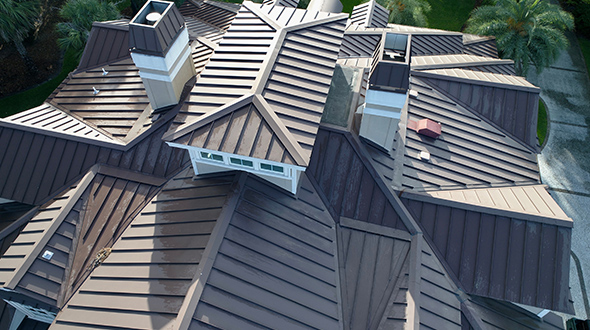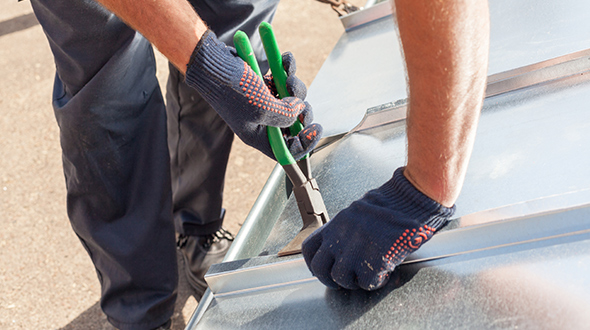
Wondering if a standing seam metal roofing system is the best roofing system for your property? Knowing how a standing seam metal roof is built, its advantages, disadvantages, and how long it lasts will help you determine whether it's right or not for your project.
atlantacommercialroofingcontractors.com gathered essential information about what a standing seam metal roof is, how one is built, how it differs from a metal roof, and its long lifespan.
What Is a Standing Seam Metal Roof
A standing seam metal roof is a roofing system consisting of metal panels joined together with raised seams. The panels are typically made from steel, aluminum, or copper and come in various colors and finishes.
"Standing seam" refers to the raised seams that run vertically along the length of each metal panel. These seams are raised above the panel surface level and are typically joined together using an interlocking mechanism. When properly installed, this creates a watertight seal that prevents water from penetrating the roof.
Standing seam metal roofing systems are popular because they are extremely durable, long-lasting, and require minimal maintenance. These roofs are energy-efficient, reflecting the sun's rays and helping keep a building’s interior cool in the summer. Additionally, they are fire-resistant and can withstand sustained high winds and other extreme weather conditions.
Components of a Standing Seam Metal Roof

A typical standing seam metal roof consists of multiple components, including the following:
- Metal Panels - These are a roof’s main structural element, typically made from steel, aluminum, or copper.
- Roof Underlayment - This protective layer is installed beneath the metal panels providing additional weather protection and preventing moisture from entering the building.
- Roof Deck - This is the roof’s foundation and is typically made from wood, metal, or concrete (depending on the structure’s construction).
- Flashing - This is typically a thin metal strip installed at the edges, penetrations, and roof seams to prevent water from penetrating the roof and causing damage or decay.
- Fasteners - These are the screws or clips used to attach the metal panels to the roof deck. They are designed to allow for the panel’s thermal movement (expansion and contraction) and prevent damage to the roof.
- Ridge Caps - These metal pieces covering the roof’s ridge (the roof’s uppermost part) provide additional weather protection.
- Snow Guards - These are devices installed on the roof to prevent snow and ice from sliding off and causing damage or injury.
Each component plays a crucial role in a standing seam metal roof’s performance and durability. Proper installation and regular maintenance of these components are essential to ensure the roofing system’s longevity and effectiveness.
Standing Seam or Metal Roof - What’s the Difference?
The terms "standing seam" and "metal roof" are frequently used interchangeably, but there is a distinct difference between them. Consider the following:
A metal roof is a roofing system made from metal materials like steel, aluminum, or copper. It can be constructed in various styles, including standing seam, corrugated, and shingle.
However, a standing seam roof is a specific metal roof type featuring raised seams that run vertically along the panels. The seams are raised above the panel surface and are typically joined using a locking mechanism, creating a watertight seal helping prevent water from penetrating the roof.

While standing seam roofs are a type of metal roof, not all metal roofs are standing seam. Other metal roof types may have different profiles, textures, and colors than standing seam roofs.
The principal difference between a standing seam roof and a metal roof is that a “standing seam” roof is a specific metal roof type featuring raised seams, while a “metal roof” refers to any roofing system made from metal components.
Standing Seam Metal Roof Pros and Cons
Standing seam metal roofs offer several advantages and disadvantages compared to other roofing systems. Consider the following pros and cons of standing seam metal roofs:
Advantages:
- Durability - Standing seam metal roofs are incredibly durable, potentially lasting 50 years or more with proper maintenance.
- Weather-Resistant - Metal roofs resist weather like high winds, hail, and heavy rain.
- Energy-Efficient - Standing seam metal roofs are reflective, helping to reduce cooling costs in warmer climates.
- Low Maintenance - Metal roofing systems require minimal maintenance and are relatively easy to clean.
- Aesthetically Pleasing - Standing seam metal roofs offer a sleek, modern look complementing various architectural styles (potentially increasing a property’s curb appeal).
Disadvantages:
- Installation Cost - Standing seam metal roofs can be significantly more expensive than other roofing systems, like asphalt shingles.
- Noise - Rain, hail, and other precipitation can be extremely noisy on metal roofs, which can be a significant concern and deciding factor for some property owners.
- Installation - Standing seam metal roof professional installation requires specialized equipment and expertise, which may add to the roof’s installation cost.
- Expansion & Contraction - Metal roofs expand and contract with temperature changes, which may cause fasteners to loosen or back out over time, potentially leading to leaks.
- Potential for Dents - Metal roofs are prone to denting when hit by large hail or other projectiles.
Standing seam metal roofs offer multiple benefits and are a popular choice for homeowners and commercial property owners wanting a durable, energy-efficient, and low-maintenance roofing solution. However, they may not be the ideal option for every roofing situation, and it's essential to weigh the advantages and disadvantages carefully before making a decision.
Standing Seam Metal Roofing System
In this article, you discovered what a standing seam metal roofing system is, its components, its lifespan, how it differs from a metal roofing system, and whether it is worth the investment.
Understanding the composition and installation of a standing seam metal roof will help you make informed decisions about replacing your current failing roof.
Misunderstanding the construction and lifespan of a standing seam metal roof will leave you potentially installing the wrong roof on your building.
Sources:
ncbi.nlm.nih.gov/pmc/articles/PMC5469659/
emilms.fema.gov/is_0285/groups/151.html
gccds.msstate.edu/research/altconstruction/roof/roof.pdf
ibhs.org/wp-content/uploads/member_docs/Performance-of-Metal-Roofing-to-Realistic-Wind-Loads_ICWE_IBHS.pdf
(404) 220-9288
The post Standing Seam Metal Roof - Everything You Need to Know appeared first on atlantacommercialroofingcontractors.com

No comments:
Post a Comment
Note: Only a member of this blog may post a comment.